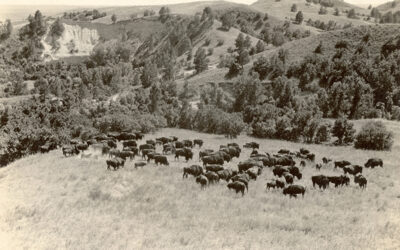
Cornhusking was once an annual autumn activity on many Nebraska farms. Before the advent of the mechanical corn picker, the corn crop was harvested by hand and “shucked” in the field. This activity usually called for extra hired men, whose only tools were pegs or hooks strapped to their palms.
A labor shortage in the fall of 1906 hampered the corn harvest in some parts of Nebraska. “Northern Nebraska farmers are crying for cornhuskers,” said the Norfolk Weekly News-Journal on November 2, 1906. “The man who can husk the golden ears and is willing to do it, can earn $2.50 a day and his board and lodging at any farm in this part of the country right [now]. Four cents a bushel is being paid, besides board and lodging, and an average cornhusker can handle sixty bushels of the kernel-laden cobs in eight hours of time. . . . Farmers living around Norfolk say that they are anxious to get men and the wages offered are tempting. Idle men anywhere are invited to join the husking bee and to get busy.”
The News-Journal on November 23 said: “The scarcity of laboring men in northern Nebraska still continues . . . . Some farmers in this section are paying as high as five cents per bushel and board, for corn husking, although the general rate being offered is four cents per bushel. At this wage, the cornhuskers are making from $3 to $4.50 and $5 per day in the field.
“Not within the memory of the oldest inhabitant has so high a wage for cornhusking been known anywhere as is being paid right here in Nebraska this fall. And the work promises to continue until well after the holidays. Some who had been anxious to get help, had counted on securing men as soon as the cement walk season had ended but laborers are just as scarce now apparently as they were in the middle of the summer.
“There promises to be plenty of work for all who are willing to work in Norfolk during the coming winter. With the cornhusking season late in starting and late in ending, together with the sewer work and the putting up of ice, there will be little time to waste by the man who is in earnest about finding a job.”
Apparently, not all farmers were willing to hire cornhuskers at such a high wage. On November 30 the Journal-News acknowledged that some farmers in northern Nebraska “take exception to the statement quoted in these columns . . . that men are commanding wages of five cents per bushel, with board, for husking corn. Three cents is declared to be the average price being paid in this section, with plenty of men at that figure.”
Photo: Photographer Solomon D. Butcher depicted the corn harvest near Lexington in Dawson County in 1905. NSHS RG2608-2332



